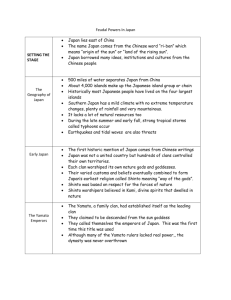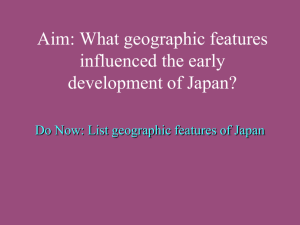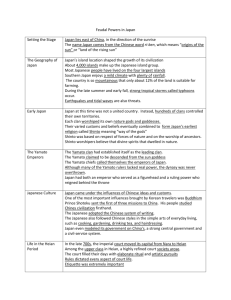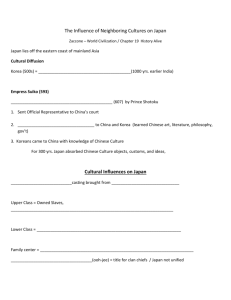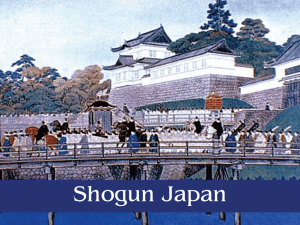The Emergence of Japan
advertisement
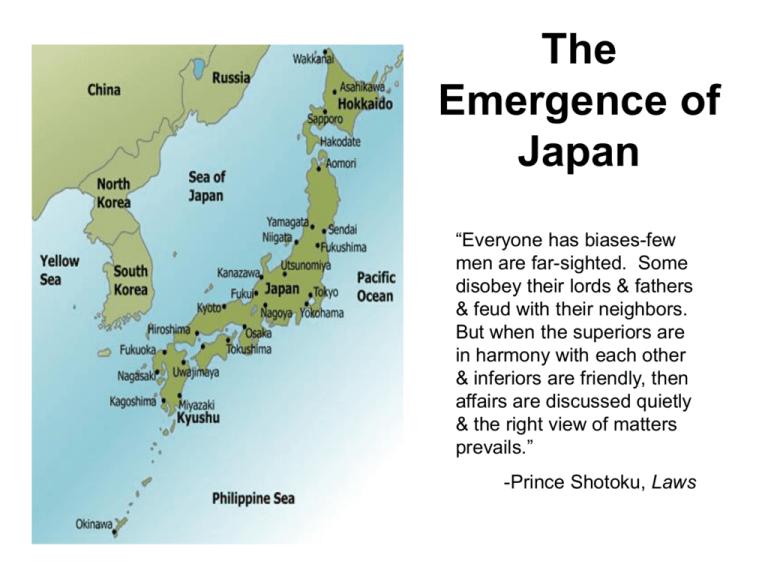
The Emergence of Japan “Everyone has biases-few men are far-sighted. Some disobey their lords & fathers & feud with their neighbors. But when the superiors are in harmony with each other & inferiors are friendly, then affairs are discussed quietly & the right view of matters prevails.” -Prince Shotoku, Laws Geography of Japan • Archipelago • 100 miles off Asian mainland-east of Korean peninsula • Four main islands • Mountainous/Ring of Fire • Protected, isolated • Trade/fishing • Mild climate • sufficient rain Early Traditions • Original inhabitants were Ainu • Others migrated from Asian mainland more than 2,000 yrs agopushed aboriginals south Yamato Clan • Early society divided into uji or clans • Each uji had chief & special god or goddess viewed as clan’s original ancestor • Some women clan leaders • 500 AD, Yamato clan set up 1st & only dynasty • Claimed direct descent from sun goddess, Amaterasu-rising sun • Emperors revered as living gods Shinto “Way of the Gods” • Uji clans honored kami/nature spirits • Shrines – mountains – waterfall – ancient gnarled trees – rocks Why is Korea viewed as a Cultural Bridge between China & Japan? • Geographic proximity-close contact • Japanese language more related to Korean than Chinese • Korean artisans & metalworkers settled in Japan • Soldiers attacked each other Buddhism • Mahayana introduced by Korean missionaries traveling on trade routes, 500 CE • Adopted by elites, then others • Brought Chinese writing & culture • Sparked interest in China • Pagoda architecture • Monasteries grew rich/powerful China Influences Japan • Early 600’s Prince Shotoku sent students, monks, traders, officials to Chinese Tang court • Philosophy/Confucianism • Technology • Arts • Government • Fashion/Music/Dances • Pottery • Food • Official writing Chinese Influences on Japanese Court • • • • • • • Changan model for Nara Emperors sought both spiritual & political power Prince Shotoku adopted aspects of Chinese government, Confucian calendar, & legal ideas Chinese character script adopted by Japanese court officials Memorization of Chinese poetry popular Collected Chinese works of art Curving, tile roofs became popular in the homes of aristocrats Taika Reforms (646 CE) • Introduced by Emperor Tenchi • Modeled on China’s Tang Confucian centralized government • Official reverence for Buddhism • Recognition of provincial administrators • Vast land reforms placed all rice-producing land in hands of emperor A Unique culture Emerges • Kept many Chinese elements but unique Japanese culture emerged • No civil service exam • No meritocracy – Officials continue to be sons of nobles • Writing- Kana or phonetic symbols representing syllables • Artistic style • Poetry-Haiku Heian Period 794-1185 • Golden Age of peace/prosperity • High point of aristocratic culture • Imperial capital in Heian (Kyoto) • Emperors had religious influence not political power • Fujiwara Clan &noble families held real political power • Needed guards, warriors for protection The Heian Court • Elegant, refined sophisticated • Pavilions, gardens • Elaborate rules of etiquette governed court ceremonyletters had to be folded properly • Elaborate makeup & clothingmulticolored silks • Restrained behavior-rude to laugh with open mouth • Lots of leisure timegames such as Go Women during Heian Period • Enjoyed a relatively strong position • Forbidden to learn Chinese-Invented Kana script • Created most important literature of the period • Could inherit & own property though usually managed by men • Laws protected them from physical violence • Could not choose husbands • No foot-binding • Polygamy typical Heian Literature • Chinese was official language of court • Kana led to new literary styles • novel • narratives (monogatari) • essays • Only nobles & Buddhist clergy were literate How did nobles gain power over the Imperial Family? • Earned trust of emperor & gained control of chancellorship • Married daughters to crown princes • Received highranking posts in government • Shoen (tax free estates) as gifts to loyal nobles • Emperor’s role became mostly ceremonial Rise of Provincial Nobles • Kyoto Court became more isolated • Provincial nobles gained power – rugged, independent, led private armies • Constantly battled for control over provinces Japan’s Feudal Age 1100-1500 • Emperor virtually powerless-only ceremonial • Shogun-supreme military commander • Daimyo/Vassal Lords -great warriors • Samurai-”those who serve”-lesser lords Who were the Samurai? • Fighting aristocracy • Heavily armed/ trained • Bushido-”way of the warrior” • Honor, bravery, absolute loyalty to one’s lord Seppuku • Ritual suicide rather than live without honor What was the Status of Noblewomen? • At first, some trained in military arts • Supervised family estates • Gradual decline of women • Inheritance limited to sons • No pedestal • Hardships & loyalty were expected Peasants • Peasants made up 75% of the population were the backbone of feudal society • Rice, other crops were grown on feudal estates • Some served as foot soldiers • Rarely a peasant might rise to samurai Artisans & Merchants • Armorers & sword makers provided goods for samurai Merchants • Lowest class but over time, gained status Mongol Invasions • • • • • Conquered China & Korea (Yuan Dynasty) 1274, Kublai Khan attempted invasion Typhoon wrecked most of fleet 1281, another invasion thwarted by typhoon Recent research suggest shoddy shipbuilding-used old wormy wood • Kamikazi-divine winds • Reinforced the idea that they were special What changes took place under the Tokugawas? • Warfare increased after Mongol invasions,1450 • peasants as well as samurai fight • General Hideyoshi brought most of Japan under his control • Tried, but failed to conquer Korea & China • 1600, Tokugawa Ieyasu became master of Japan-named Shogun • Tokugawa Shogunate ruled until 1868 Zen Buddhism • Sect from China • Adopted by samurai • Meditation (zazen) • Scholarship vs the “uncluttered mind” • Compassion vs killing • freedom vs control Zen Influence • Devotion to nature-landscape gardening • Enlightenment through everyday tasks-“Chop wood/carry water” • Values of peace, simplicity and love of beauty-tea ceremony, flower arranging • Fine landscape paintings • Tea ceremony Wabi Sabi Artistic Traditions • Edo and Osaka were centers for the Arts • Development of urban, sophisticated culture • Emphasized luxury and pleasure Noh Theater • 1300’s –Noh • Men wore elegant, carved masks • Chorus chanted lines to music • Action was slow • Each movement had meaning • Zen themes-renounce selfish desires • Fairy tales • Struggles between rival lords Kabuki Theater • Developed by actress, Okuni • women were banned from performing • 1600’s towns/cities developed Kabuki • Influenced by Noh plays • Less refined • Comedy • Melodrama • Family or historical events • Colorful costumes • Lively and exaggerated movements Kabuki Theater • Drama was accompanied on a samisen • Single performance might last a whole day • Audience witnessed the scenery changes • Fans shout the name of favorite actors Bunraku • Puppet theater • Catered to popular middle-class tastes Literature • Tale of the Heike- violent conflict between two families • Essays in Idleness by Kenko • Zen values • observations about human nature Painting/Printmaking • • • • • • • • • Landscapes Scrolls Historical events Urban culture Woodblock prints to satisfy wealthy middle-class Humor Fresh colors Simple lines Pleasures of town life
